Original Samsung
On August 24, sales of the Samsung Galaxy Note 10.1 tablet started. A day before the official start of sales, I had the opportunity to get acquainted with this device. Total, at the moment I have been using it for the 5th day. It's time to share your first impressions and thoughts.
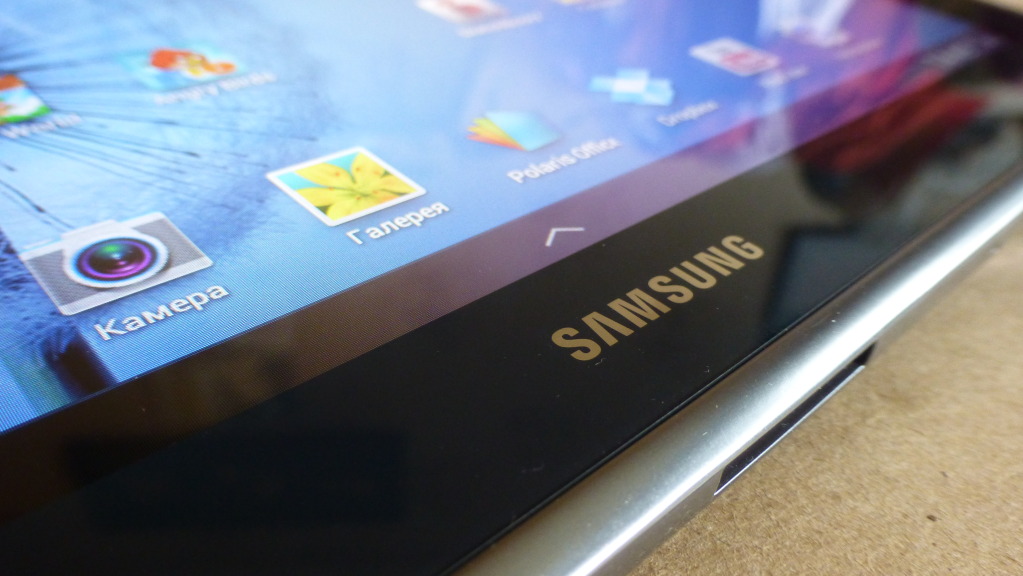
I first saw the Samsung Galaxy Note 10.1 in February this year at the Barcelona Mobile Congress and, frankly, then it did not impress me at all. One fact that the stylus, or S-Pen, did not fit into the tablet’s body, caused a slight bewilderment. With the original, 5.3-inch Note, this his older brother did not go to any comparison, and therefore, to be honest, I forgot to think about this model. Yes, and Samsung did not put it on sale. And so, six months passed and Note 10.1 still appeared on the shelves. But it turned out to be a completely different device both in terms of configuration, and in functionality, and, in part, in appearance.
Firstly, the case now has a place for the S-Pen. And when you get the stylus out of its slot-cell, the display automatically unlocks. Very nice and convenient nuance! Developed by S-Pen by Wacom, one of the most reputable companies among graphic tablet manufacturers.
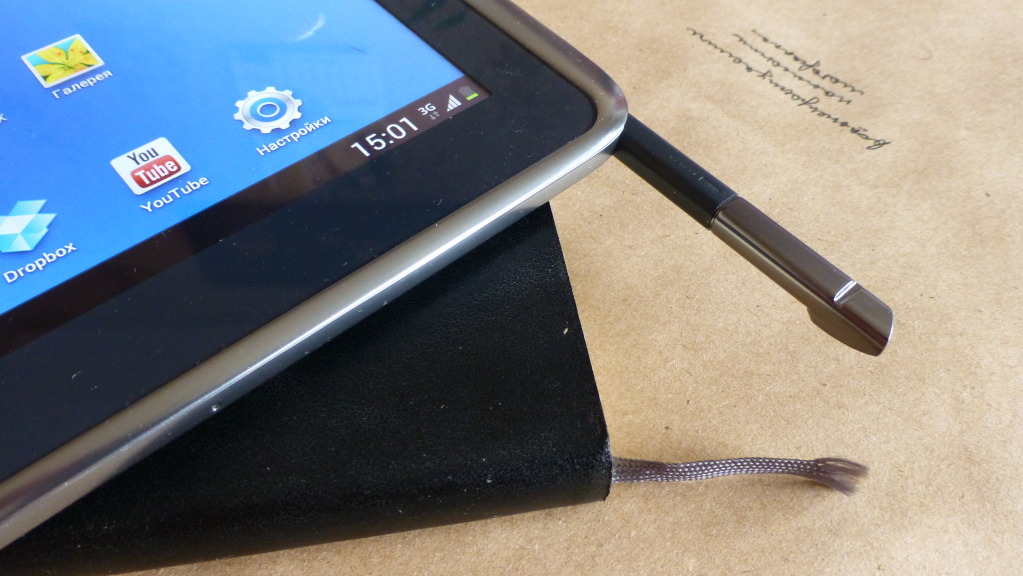
In collaboration with Wacom, the Samsung Galaxy Note 10.1 display was also created. With the display, at first glance, there is one problem, or rather even two: firstly, it is not Amoled, which we are so used to on Samsung devices, and secondly, its resolution is absolutely standard for 10-inch tablets a year ago: 1280x800. For comparison, the classic Galaxy Note has a Super Amoled display, and the resolution of the 5.3-inch display is exactly the same - 1280x800. That is, the display of the Galaxy Note 10.1 is almost twice as large at the same resolution. But why? And why is the display not Amoled, but PLS? After all, the device is clearly flagship in configuration: the quad-core Exynos 4412 processor with the Mali 400 graphics accelerator and as much as 2 GB of RAM. Well, Samsung could not just out of greed or laziness to install a non-flagship screen!
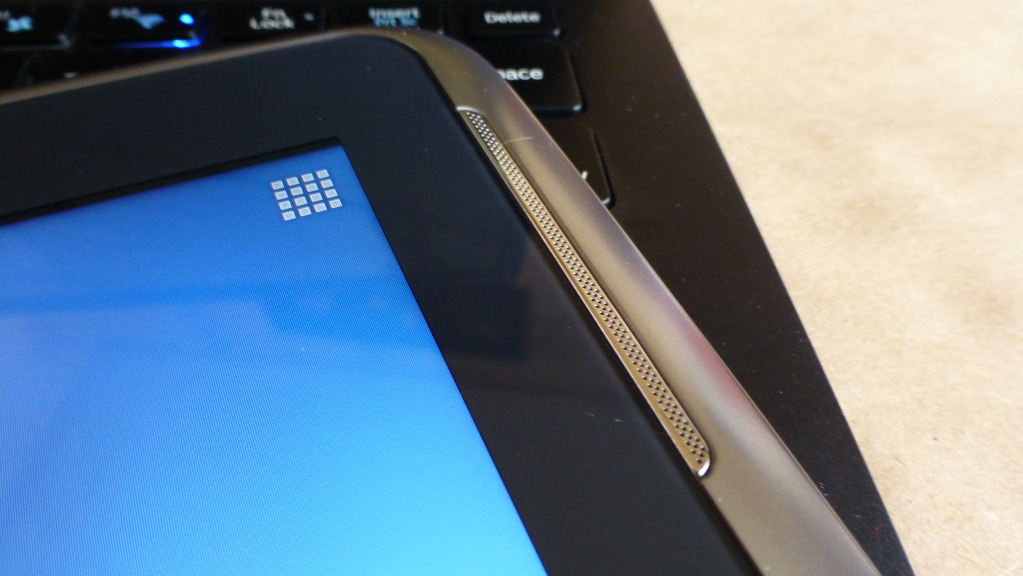
These questions disappeared by themselves when I showed both Galaxy Note to a familiar artist. He quite intelligibly explained to me the possible logic of Samsung. The case was as follows. Everyone knows that Amoled displays are overly juicy. It would simply mislead the artist who would draw one picture on the Galaxy Note 10.1, and then on another non-Amoled display would get another. As for permission, then everything turned out to be logical and simple. The fact is that with a very high resolution, accurate pen input would be difficult. That is, the artist would have to constantly zoom in on the drawing in order to get exactly into the pixel that he needed to get into. By the way, my friend liked the device very much, he spent a whole day with it,

As for the PLS matrix, in practice and with a more detailed examination of the technical characteristics, it turned out to be not at all bad, which for some reason they began to consider because of its cheapness in production. So, for example, it turned out that the pixel density of PLS is higher than that of IPS, PLS has better color rendering and viewing angles, greater brightness, lower power consumption and sRGB coverage is full.
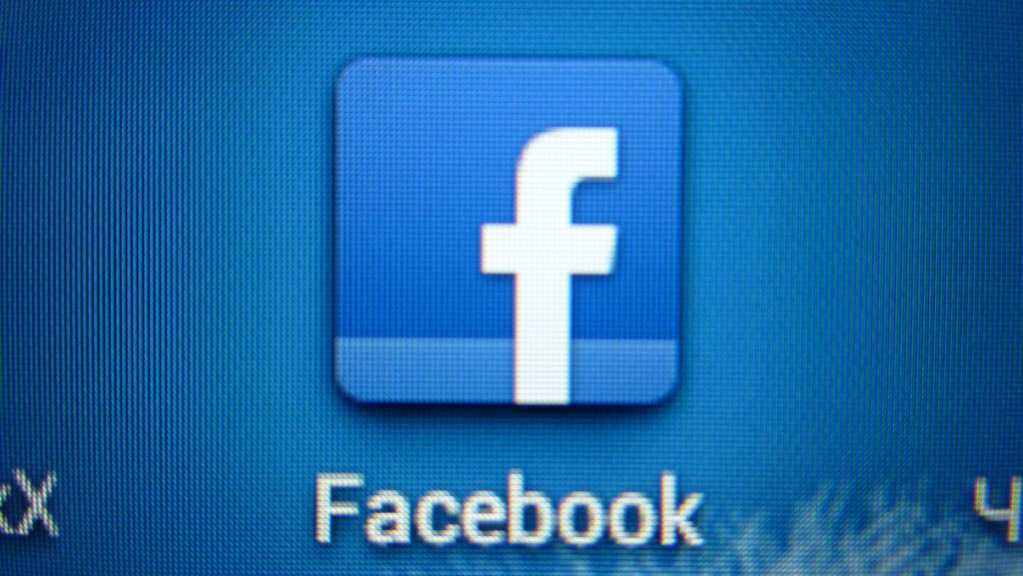
Later, while pondering over the arguments of a friend of mine, I suddenly realized that Apple was really to blame for my bewilderment of the display resolution in Galaxy Note 10.1. The apple company has created a trend to increase the resolution of displays, is actively developing it, and therefore, we consumers have believed that, yes, indeed, high resolution displays is the most important factor. But it turned out that this is not always a high resolution for the benefit. I'm not talking about the fact that in the new iPad, due to the super-high resolution of the display, there were problems that were not in iPad2 (for example, the display does not always have time to recognize keystrokes when typing and often instead of “when” or “pro” prints simply “and” or “about”).
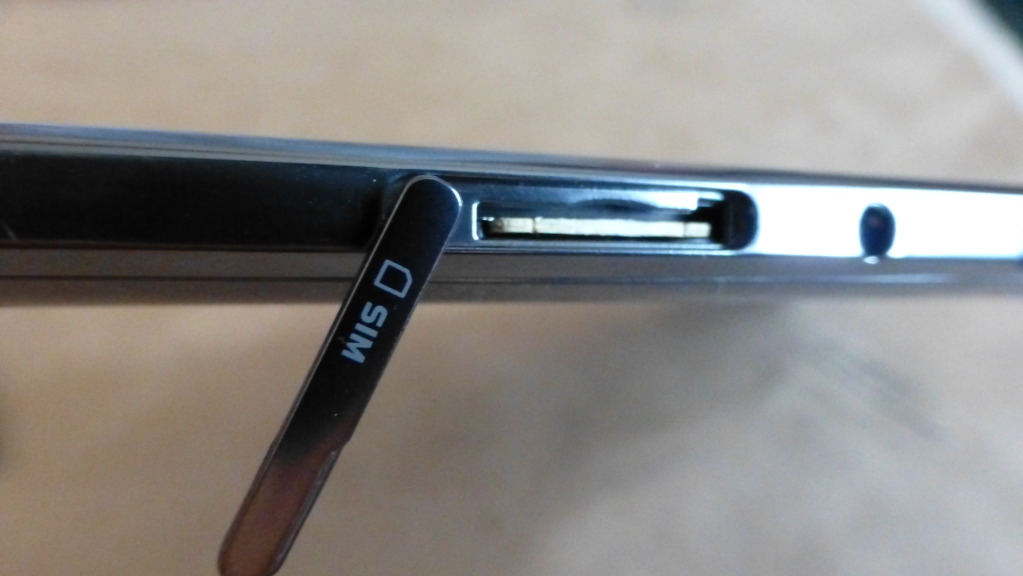
Well, okay, let's move on to the device. From the first glance at the tablet, the location of the speakers was very pleasing - they are placed on the front surface so that under almost no circumstances they can be clasped by the palms. At the same time, the speakers are quite loud. Not to say that in the frequency range they are able to replace full-fledged, portable speakers, but, nevertheless, they play music loudly. Yes, by the way, judging by the location of both the speakers and the front camera (1.9 megapixels) for video communications, the tablet is intended for use mainly in horizontal orientation, although, of course, a full screen rotation is supported by the interface.
All hardware buttons are placed on the upper side face. Here is the on / off button (it is also the display unlock button), volume swing, slots for SIM-card (full-sized) and micro-SD card. There is also a 3.5 headphone jack. The connector for charging and switching to a computer is placed on the lower side, and it is not the usual micro-USB, but a special, Samsung 30-pin. Honestly, it is a pity that there is no micro-USB connector in the device at all. Thus, we are doomed to carry another cord. And it's not that the tablet needs to be recharged during the day. Just not. The Galaxy Note 10.1 has a 7000 mAh battery, which, under any load, lasts 9-10 hours to use the device without any problems. But to connect the tablet to a computer for data exchange, for example, without this same 30-nin cord will not work. And this, in my opinion, a minus, because such a need may arise, because the Galaxy Note 10.1 has a very good 5MP main camera with an LED flash. She doesn’t shoot the video, not FullHD, but simple HD (720p), but of pretty good quality.
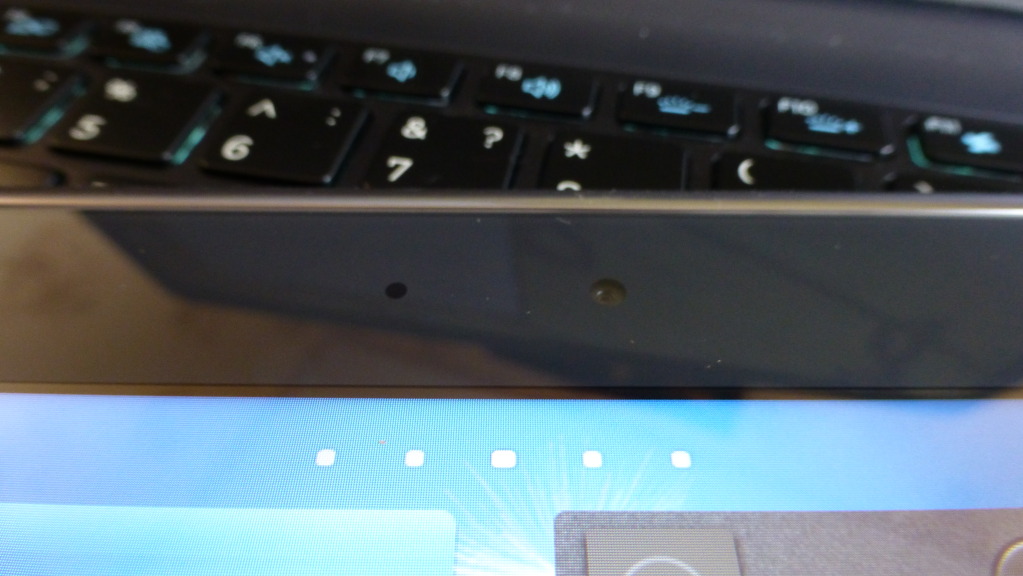
Another nice nuance I would like to note: Galaxy Note 10.1 supports the functionality of telephone communications. Honestly, I could never understand why the same iPad, and some other Android tablets do not allow you to call or call them. That is, from a marketing point of view, of course, everything is clear, but on the other hand, because devices are for users, not users for devices! Of course, holding your ear with a 10-inch tablet, with all the desire, will not work, but using a speakerphone or headphones is very convenient. In any case, one of the days I inserted my main phone SIM card into the Galaxy Note 10.1 and used the tablet, among other things, and as a phone. I did not feel any discomfort. However, for the sake of truth, I’ll say that on the phone I often turn on the speakerphone or speak through the connected headset.
And one more nuance: the infrared port is located on the upper side face! This is a completely different direction of using the Galaxy Note 10.1. That is, it turns out that the Galaxy Note 10.1 is designed to become a hub for managing home appliances. The Smart Remote application is responsible for the operation of the infrared port, in which support for many TVs and projectors of various brands is already embedded. So setting up the Galaxy Note 10.1 to work as a remote control shouldn't be a problem. However, I’m sure this direction will continue to develop, and it is possible that thanks to the infrared port, Galaxy Note 10.1 will become the first model of a whole line of devices, among other things designed to control other devices.

Now let's talk about Galaxy Note 10.1 software. And there is something to say except that as a pre-installed OS, the tablet carries Android ICS 4.0.4. Even in Android for the Galaxy SIII, Samsung introduced several chips that favorably distinguish the Samsung assembly of this open OS from other versions. Almost the most remembered function there was Pop Up Play, which allowed to display the video played in the player on top of other open applications in a small window. However, on the 4.8-inch SIII display, this function did not look very relevant. But in the Galaxy Note 10.1 Pop Up Play looks very handy.

But that is not all! In Android on Galaxy Note 10.1, full-fledged multitasking first appeared, allowing you to simultaneously work in two open and active applications. To be honest, this is a breakthrough. Because all these years we were told about the multitasking of Android, which at the same time calmly continued to euthanize the apps that were taken to the background. And finally, the first device appeared, on which you can not only play videos on top of an open browser or social network agent, but also keep open, for example, the same browser, and notes, or an office. Currently, only six applications support multi-window mode: browser, Polaris-office, S-Note, video player, gallery and E-Mail. Alas, this list does not yet have a player for YouTube, the same phone, or a client for SMS messages. I would like to open a lot of other things at the same time on the 10-inch display. But, most importantly, the first step has been taken and, I am sure, over time, in new firmware, the number of applications configured to work in multi-window mode will become larger. Fortunately, the power of the filling device allows this.
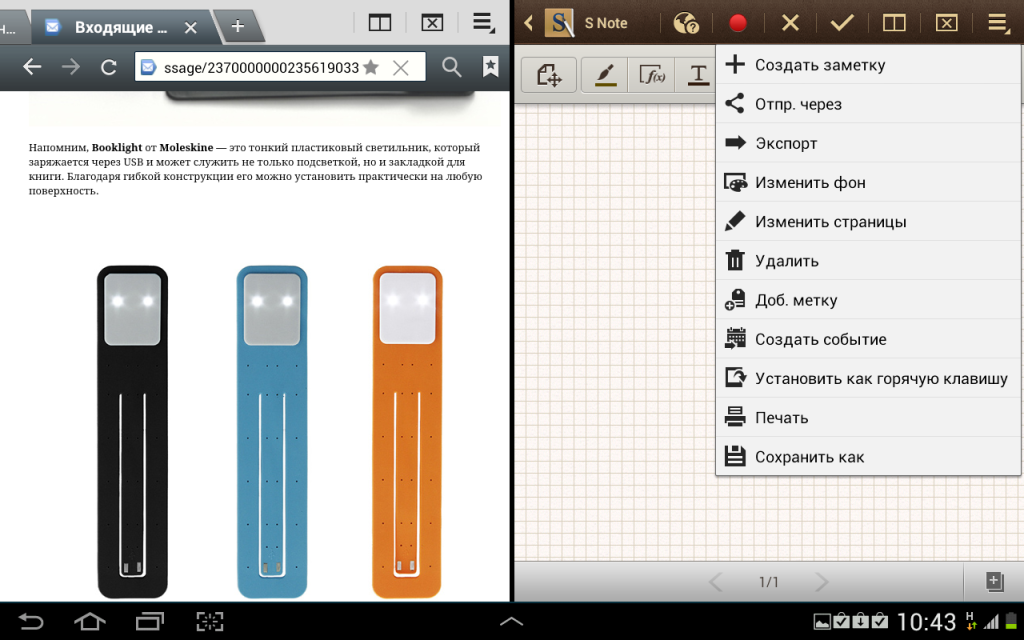
Summing up this preliminary review, I’ll say that, in my opinion, Samsung turned out to be frankly innovative, and in the context of litigation with Apple, a distinctive device. Here Apple will definitely not find reasons for nit-picking. It seems to me that pen input is a very relevant and promising direction. The only thing that I’m not too lazy to say again is that Samsung really needs its own OS, not modified Android, namely its own OS, albeit supporting the application base from the Android Play Market, but its own, developed if not for a specific device, then at least for a specific line of devices. And the Note line, in my opinion, is the best candidate for this new OS. It’s a pity that shortly before the start of sales of Galaxy Note 10.1, Samsung postponed the release date of the first Tizen device from the end of 2012, for 2013. Well, we will wait.
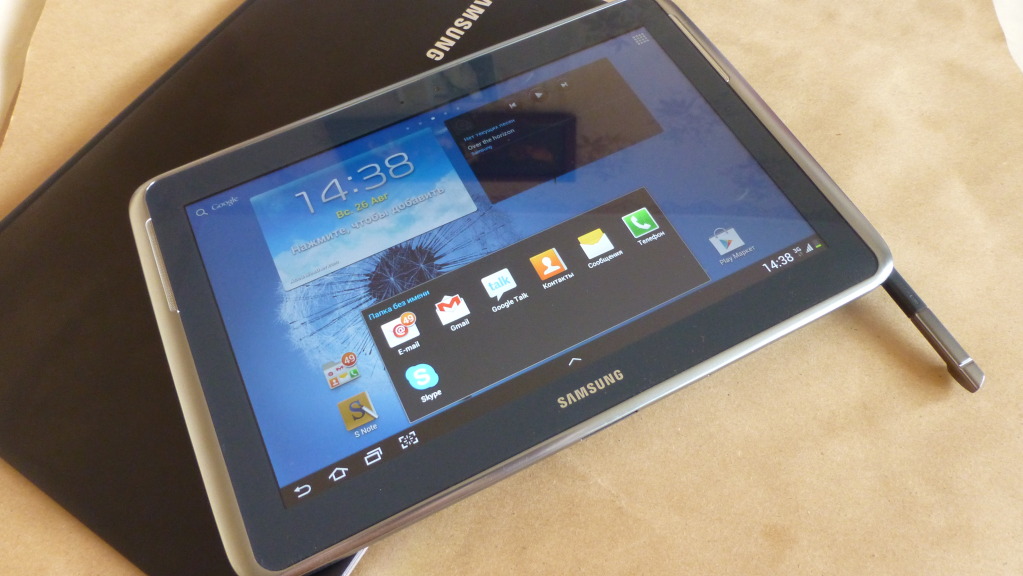

I first saw the Samsung Galaxy Note 10.1 in February this year at the Barcelona Mobile Congress and, frankly, then it did not impress me at all. One fact that the stylus, or S-Pen, did not fit into the tablet’s body, caused a slight bewilderment. With the original, 5.3-inch Note, this his older brother did not go to any comparison, and therefore, to be honest, I forgot to think about this model. Yes, and Samsung did not put it on sale. And so, six months passed and Note 10.1 still appeared on the shelves. But it turned out to be a completely different device both in terms of configuration, and in functionality, and, in part, in appearance.
Firstly, the case now has a place for the S-Pen. And when you get the stylus out of its slot-cell, the display automatically unlocks. Very nice and convenient nuance! Developed by S-Pen by Wacom, one of the most reputable companies among graphic tablet manufacturers.

In collaboration with Wacom, the Samsung Galaxy Note 10.1 display was also created. With the display, at first glance, there is one problem, or rather even two: firstly, it is not Amoled, which we are so used to on Samsung devices, and secondly, its resolution is absolutely standard for 10-inch tablets a year ago: 1280x800. For comparison, the classic Galaxy Note has a Super Amoled display, and the resolution of the 5.3-inch display is exactly the same - 1280x800. That is, the display of the Galaxy Note 10.1 is almost twice as large at the same resolution. But why? And why is the display not Amoled, but PLS? After all, the device is clearly flagship in configuration: the quad-core Exynos 4412 processor with the Mali 400 graphics accelerator and as much as 2 GB of RAM. Well, Samsung could not just out of greed or laziness to install a non-flagship screen!

These questions disappeared by themselves when I showed both Galaxy Note to a familiar artist. He quite intelligibly explained to me the possible logic of Samsung. The case was as follows. Everyone knows that Amoled displays are overly juicy. It would simply mislead the artist who would draw one picture on the Galaxy Note 10.1, and then on another non-Amoled display would get another. As for permission, then everything turned out to be logical and simple. The fact is that with a very high resolution, accurate pen input would be difficult. That is, the artist would have to constantly zoom in on the drawing in order to get exactly into the pixel that he needed to get into. By the way, my friend liked the device very much, he spent a whole day with it,

As for the PLS matrix, in practice and with a more detailed examination of the technical characteristics, it turned out to be not at all bad, which for some reason they began to consider because of its cheapness in production. So, for example, it turned out that the pixel density of PLS is higher than that of IPS, PLS has better color rendering and viewing angles, greater brightness, lower power consumption and sRGB coverage is full.

Later, while pondering over the arguments of a friend of mine, I suddenly realized that Apple was really to blame for my bewilderment of the display resolution in Galaxy Note 10.1. The apple company has created a trend to increase the resolution of displays, is actively developing it, and therefore, we consumers have believed that, yes, indeed, high resolution displays is the most important factor. But it turned out that this is not always a high resolution for the benefit. I'm not talking about the fact that in the new iPad, due to the super-high resolution of the display, there were problems that were not in iPad2 (for example, the display does not always have time to recognize keystrokes when typing and often instead of “when” or “pro” prints simply “and” or “about”).

Well, okay, let's move on to the device. From the first glance at the tablet, the location of the speakers was very pleasing - they are placed on the front surface so that under almost no circumstances they can be clasped by the palms. At the same time, the speakers are quite loud. Not to say that in the frequency range they are able to replace full-fledged, portable speakers, but, nevertheless, they play music loudly. Yes, by the way, judging by the location of both the speakers and the front camera (1.9 megapixels) for video communications, the tablet is intended for use mainly in horizontal orientation, although, of course, a full screen rotation is supported by the interface.
All hardware buttons are placed on the upper side face. Here is the on / off button (it is also the display unlock button), volume swing, slots for SIM-card (full-sized) and micro-SD card. There is also a 3.5 headphone jack. The connector for charging and switching to a computer is placed on the lower side, and it is not the usual micro-USB, but a special, Samsung 30-pin. Honestly, it is a pity that there is no micro-USB connector in the device at all. Thus, we are doomed to carry another cord. And it's not that the tablet needs to be recharged during the day. Just not. The Galaxy Note 10.1 has a 7000 mAh battery, which, under any load, lasts 9-10 hours to use the device without any problems. But to connect the tablet to a computer for data exchange, for example, without this same 30-nin cord will not work. And this, in my opinion, a minus, because such a need may arise, because the Galaxy Note 10.1 has a very good 5MP main camera with an LED flash. She doesn’t shoot the video, not FullHD, but simple HD (720p), but of pretty good quality.

Another nice nuance I would like to note: Galaxy Note 10.1 supports the functionality of telephone communications. Honestly, I could never understand why the same iPad, and some other Android tablets do not allow you to call or call them. That is, from a marketing point of view, of course, everything is clear, but on the other hand, because devices are for users, not users for devices! Of course, holding your ear with a 10-inch tablet, with all the desire, will not work, but using a speakerphone or headphones is very convenient. In any case, one of the days I inserted my main phone SIM card into the Galaxy Note 10.1 and used the tablet, among other things, and as a phone. I did not feel any discomfort. However, for the sake of truth, I’ll say that on the phone I often turn on the speakerphone or speak through the connected headset.
And one more nuance: the infrared port is located on the upper side face! This is a completely different direction of using the Galaxy Note 10.1. That is, it turns out that the Galaxy Note 10.1 is designed to become a hub for managing home appliances. The Smart Remote application is responsible for the operation of the infrared port, in which support for many TVs and projectors of various brands is already embedded. So setting up the Galaxy Note 10.1 to work as a remote control shouldn't be a problem. However, I’m sure this direction will continue to develop, and it is possible that thanks to the infrared port, Galaxy Note 10.1 will become the first model of a whole line of devices, among other things designed to control other devices.

Now let's talk about Galaxy Note 10.1 software. And there is something to say except that as a pre-installed OS, the tablet carries Android ICS 4.0.4. Even in Android for the Galaxy SIII, Samsung introduced several chips that favorably distinguish the Samsung assembly of this open OS from other versions. Almost the most remembered function there was Pop Up Play, which allowed to display the video played in the player on top of other open applications in a small window. However, on the 4.8-inch SIII display, this function did not look very relevant. But in the Galaxy Note 10.1 Pop Up Play looks very handy.

But that is not all! In Android on Galaxy Note 10.1, full-fledged multitasking first appeared, allowing you to simultaneously work in two open and active applications. To be honest, this is a breakthrough. Because all these years we were told about the multitasking of Android, which at the same time calmly continued to euthanize the apps that were taken to the background. And finally, the first device appeared, on which you can not only play videos on top of an open browser or social network agent, but also keep open, for example, the same browser, and notes, or an office. Currently, only six applications support multi-window mode: browser, Polaris-office, S-Note, video player, gallery and E-Mail. Alas, this list does not yet have a player for YouTube, the same phone, or a client for SMS messages. I would like to open a lot of other things at the same time on the 10-inch display. But, most importantly, the first step has been taken and, I am sure, over time, in new firmware, the number of applications configured to work in multi-window mode will become larger. Fortunately, the power of the filling device allows this.

Summing up this preliminary review, I’ll say that, in my opinion, Samsung turned out to be frankly innovative, and in the context of litigation with Apple, a distinctive device. Here Apple will definitely not find reasons for nit-picking. It seems to me that pen input is a very relevant and promising direction. The only thing that I’m not too lazy to say again is that Samsung really needs its own OS, not modified Android, namely its own OS, albeit supporting the application base from the Android Play Market, but its own, developed if not for a specific device, then at least for a specific line of devices. And the Note line, in my opinion, is the best candidate for this new OS. It’s a pity that shortly before the start of sales of Galaxy Note 10.1, Samsung postponed the release date of the first Tizen device from the end of 2012, for 2013. Well, we will wait.

